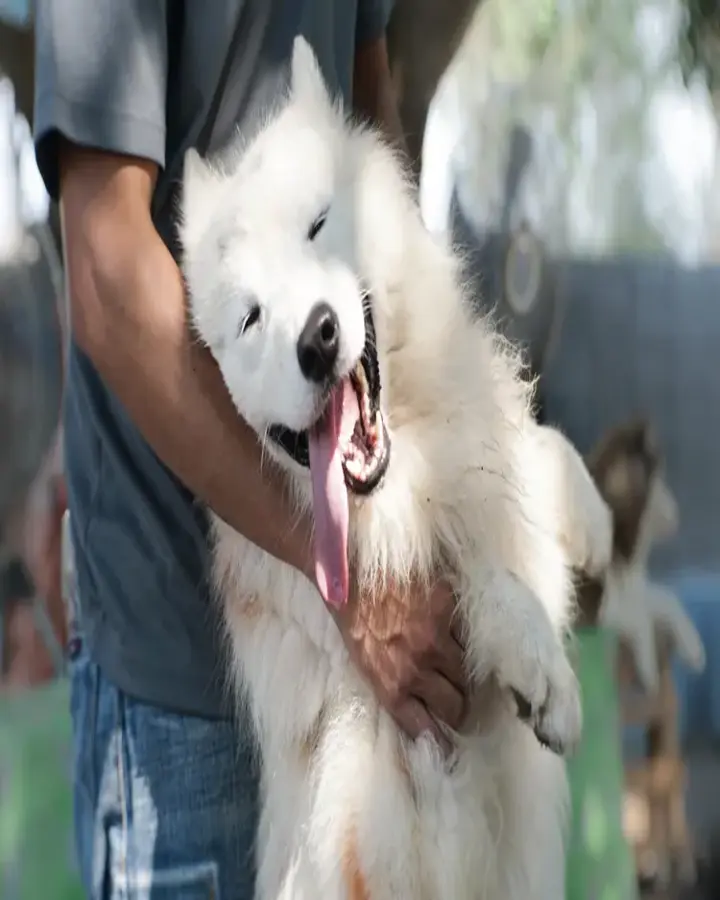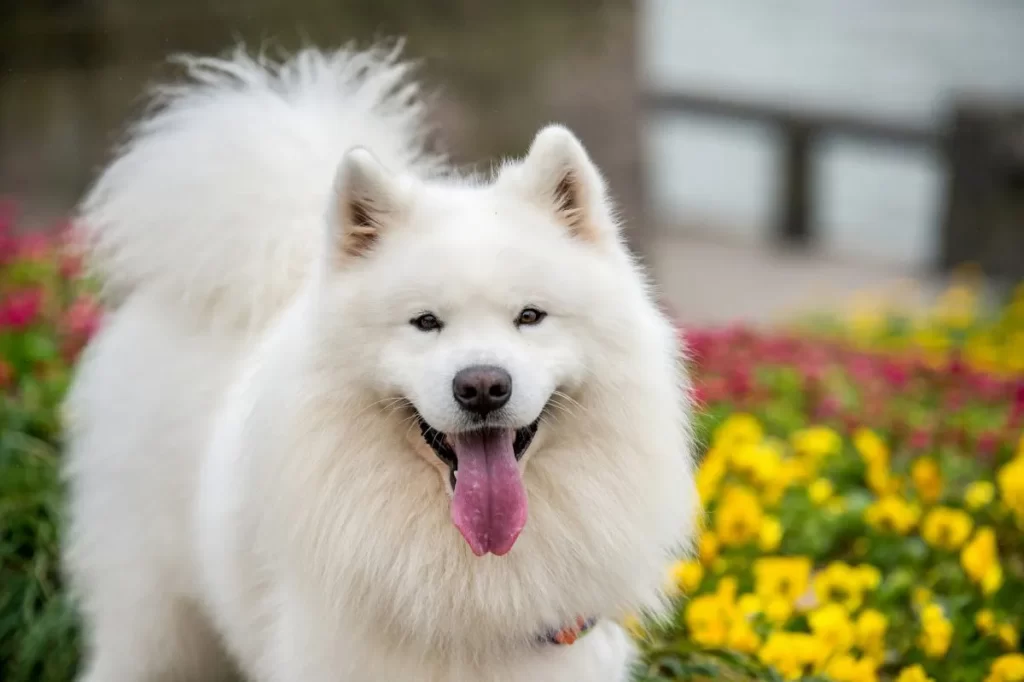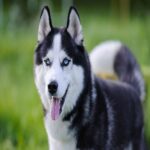
Image Credit – Hemapriya
The Samoyed is a stunningly beautiful and affectionate breed, instantly recognizable by its thick white coat and iconic “Sammy smile.” Originally bred to herd reindeer and pull sleds in Siberia, these dogs are not only hardworking but also extremely friendly and sociable. Their playful nature and deep bond with families make them a popular choice among dog lovers worldwide. Whether you’re considering adopting one or just curious about this majestic breed, you’re in the right place!
In ancient times, as the population of the Iranian plateau increased, stronger tribes drove weaker ones into the wilderness, and eventually, the Samoyed people wound up in Siberia. A gentle, nomadic tribe of family groups, they were accompanied everywhere by their dogs. The Samoyed people used the dogs to herd reindeer, pull sledges loaded with goods, and keep them warm in the frigid Siberian winters. The temperament of the well-bred Samoyed is a reflection of the breed’s beginning: brought up within the family, eating at the campfire, snuggling in the beds, this dog is the ultimate companion, gentle with family members and happy to work.
The Samoyed : Perfect Guide

The first written comments about Samoyeds were in 1696, when Adam Brand wrote of white dogs shorn to the skin pulling sleds. These dogs were depicted as medium-sized, with a curved tail quite unlike the tightly curled tail of today’s Sammy. Pictures and descriptions from 1787-89 identified the dogs as terrier types, bearing little resemblance to the magnificent modern Sammy.
The first mention of Samoyeds outside Russia comes from an English newspaper advertisement in 1891, placed by Ernest Kilburn-Scott, offering for sale “lovely white Russian (Samoyed) sledge dog pups, like small polar bears, most gentle and affectionate. Splendid coats and tails. Very rare. Parents imported.”
At about the same time, Arctic explorers were putting together teams of dogs for polar expeditions, and Samoyeds fit the bill for their stamina and willingness to work. In 1911, a Samoyed lead dog on Roald Amundsen’s trip to the South Pole was the first animal over the pole.
The Samoyed today
The breed’s history seems contrary to the Samoyed today, for few people captivated by the dog’s long white coat, smiling face, and affection for people can imagine it pulling a sled or herding reindeer. The Sam seems more at home on a sofa than in harness, but in truth, he is happy in both places.
Recognized by the American Kennel Club in 1906, the Samoyed is a member of the Working Group (although some fanciers think the breed could do equally well in the Herding Group). The breed standard describes it as a medium-sized dog of moderate build, almost square, with the length slightly longer than the height. It is a double-coated breed, well suited for work in cold weather. The undercoat is short, soft, and thick, and the guard coat is long and harsh with straight hairs standing straight out from the body. The Samoyed people combed the undercoat for use in yarns, and today some spinners include Sam hair in hats, sweaters, and scarves.
Although the original Samoyed dogs were of several colors, the standard calls for the coat to be white, cream, biscuit, or white and biscuit. All other colors are disqualifications. Most Samoyeds are white, and many have biscuit marking on the ears and around the eyes.
The eyes should be dark, and the lips and eye rims black. The nose should also be black, but a liver, brown, or Dudley (flesh-colored) nose is acceptable. Blue eyes are disqualifications.
The Samoyed should move at a trot with grace and dignity. His is a ground-consuming, steady pace, well-suited for herding reindeer over the tundra or pulling a sled to the South Pole. He has a deep chest, well-sprung ribs, strong loin, well-muscled rear and strong neck. Males should be masculine without being aggressive; females feminine without appearing weak.
Owning a Samoyed
In spite of his beauty and affectionate manner, the Samoyed can be a difficult dog to own. He requires considerable grooming to prevent matting and keep his coat clean. He sheds profusely each year, leaving white hair everywhere. Grooming is important to help keep him comfortable if your area has hot, humid summers. Although highly intelligent, this breed can be difficult to train, for the dogs have a mind of their own. They tire quickly of repetitive training, so do better with motivation than with correction. However, strong correction is sometimes needed, for the dog will run the show if not notified that the handler is in charge. Some Sams resent obedience training so much that they perform their exercises with a hang-dog look, convincing spectators that the owner must frequently beat the dog into submission. One Samoyed is well-known for fleeing into any open crate when she is taken off-lead in obedience class. However, for those with a sense of humor to cope with this recalcitrance and who have the time to groom, the Samoyed is a wonderful family pet. The breed is good with children, loves to play, and has a sense of humor. Sams are good watchdogs, wonderful therapy dogs, and competitive in agility.
Health
Generally healthy, the Samoyed, like most medium and large breeds, can be plagued by hip dysplasia. Recent findings also indicate a predisposition to hypothyroidism and related autoimmune diseases such as von Willebrand’s Disease, a bleeding disorder.
Fleas and tapeworms (carried by fleas) can be a problem because of the breed’s long coat, so prevention is especially important. Any veterinarian can recommend a flea prevention program.
As with any breed, visit several breeders before making a decision. Since the Samoyed bonds so closely with people, look for a breeder who whelps puppies in the house instead of a kennel. The pups should be exposed to the sights, smells, and sounds of family living from the day they are born. They should be played with, allowed to romp inside and out, and accustomed to different surfaces and situations. Parents of the litter should be OFA registered to decrease the chance of hip dysplasia, and they should have obedience titles in their pedigrees to indicate trainability.
The Samoyed has changed little in temperament, appearance, and ability from the time and place of his origin. He is still the consummate family dog, affectionate to almost everyone, at home on sofa or in harness, traveling hither and yon with his master. No one could possibly be lonesome with a Samoyed for a companion.
The Samoyed is much more than just a pretty face. With the right care, training, and love, they make fantastic companions full of energy, affection, and loyalty. If you’re ready for a lifelong furry friend who thrives on human interaction and activity, the Samoyed might be your perfect match. Let us know in the comments if you have a Samoyed or are thinking about welcoming one into your home!
Frequently Asked Questions
Is the Samoyed a good family dog?
Yes, the Samoyed is known for being gentle, friendly, and great with children, making it an excellent choice for families.
How much grooming does the Samoyed need?
The Samoyed requires regular brushing (at least a few times a week) to maintain its thick, double-layer coat and minimize shedding.
Does the Samoyed get along with other pets?
Generally, the Samoyed is sociable and can get along well with other pets when properly socialized from a young age.






